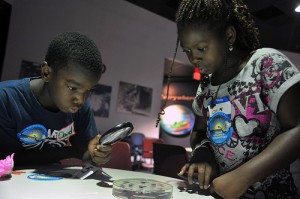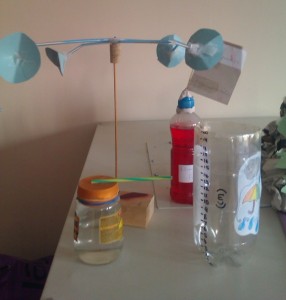In our last issue, we focused on how scientists use proxies, or preserved physical characteristics of the past, to help them understand Earth’s past climates. This time, we’re focusing on how scientists study Earth’s climate in present times – and make predictions about the future.
So how do they do it? In a nutshell, scientists make observations, collect data, analyze it, and create computer models to help them understand climate and predict what climate will be like in the future. Concept B of Essential Principle 5 (read more in the Earth’s Changing Climate: How Do We Know What We Know?) explains further:
Environmental observations are the foundation for understanding the climate system. From the bottom of the ocean to the surface of the Sun, instruments on weather stations, buoys, satellites, and other platforms collect climate data.
In this article, we highlight lessons that either allow students to collect and analyze data or learn about tools and technologies that make data collection possible. Many of these lessons include the collection of weather data, which may seem to blur the distinction between weather and climate. We recommend not worrying too much about this distinction with elementary students, as they typically have a difficult time understanding the difference between the two concepts. Providing opportunities to collect and analyze data will have the greater benefit in the long run.
For each science lesson, we’ve included the appropriate content standard from the National Science Education Standards. You can read the entire National Science Education Standards online for free or register to download the free PDF. The content standards are found in Chapter 6.
Building Weather Instruments, Collecting Weather Data
Weather Stations: Teaching the Science and Technology Standard (Grades K-5)
This article from the Beyond Penguins and Polar Bears magazine provides resources for creating a weather station, collecting and sharing data, and assessing students’ understanding of weather tools. Lessons and activities in this article align with the Earth and Space Science and Science and Technology Content Standards of the National Science Education Standards.
Calendar & Weather Book (Grades K-2)
Students will record and track weather patterns daily throughout the year. This activity is well suited for inclusion in a morning meeting or circle time. This lesson meets these content standards of the National Science Education Standards: Science as Inquiry, Earth and Space Science, and Science and Technology.
The following investigations are meant to be used as a comprehensive unit on weather. This unit meets the National Science Education Standards content standards Science as Inquiry, Earth and Space Science, and Science and Technology.
Clouds (Grades 3-5)
Students observe and record different types of clouds.
Thermometers (Grades 3-5)
Students practice using thermometers, make homemade thermometers, and use thermometers to record and graph temperature data.
Wind (Grades 3-5)
Students create a wind vane and an anemometer and then use their instruments to observe and record weather data.
Air Pressure and Barometers (Grades 3-5)
Students learn about barometric pressure, create a homemade barometer, and observe and record weather data.
Collecting Weather Data (Grades 3-5)
In this investigation, students collect weather data for two weeks. They will start seeing patterns and be able to make predictions.
Interpreting Weather Data (Grades 3-5)
Students graph, compare, and interpret the weather data from Collecting Weather Data.
Wonderful World of Weather (Grades 3-6)
This resource includes a series of lessons that allow elementary students to investigate weather phenomena both locally and in other places around the world. Students engage in hands-on activities and real-time data investigations using information available on the Internet. This combination of local and global explorations allows them to relate what they are observing locally to what is happening in remote locations. Through these explorations, students develop a basic understanding of how weather can be described in measurable quantities, such as temperature, wind and precipitation. The lessons meet the Science as Inquiry and Earth and Space Science content standards of the National Science Education Standards.
Weather Balloons
Designing Payloads (Grade 5 and up)
In this article from the NSTA journal Science and Children, fifth-grade teacher Linda Kehr describes a project in which students learned about using weather balloons as satellites and participated in launching a high-altitude balloon satellite as the culminating experience. NSTA members can download and read the article for free; nonmembers are charged $0.99. The activities described in this article meet the Science as Inquiry, Physical Science, Earth Science, and Science and Technology content standards of the National Science Education Standards.
Satellites
Keep Your Eye on the Sky – Clouds and Weather (Grade 5 and up)
Students will learn about two types of weather satellites, research cloud formations to identify weather patterns, learn that clouds can be used for real-time weather forecasting at an individual and local level, and gather cloud and temperature data to be used in creating graphs and reports. This lesson meets the Science as Inquiry, Earth and Space Science, and Science and Technology content standards of the National Science Education Standards.
Buoys
Adopt-a-Buoy: A Data and Graphing Extension Lesson (Grade 5 and up)
In this lesson, students adopt a buoy and monitor the current weather conditions at that location on a daily or weekly basis. They graph their data and then present a “data story” to their classmates. This lesson uses data from the Gulf of Maine Ocean Observing System; you could supplement with data from the National Data Buoy Center. This lesson meets the Science as Inquiry, Earth and Space Science, and Science and Technology content standards of the National Science Education Standards.
This article was written by Jessica Fries-Gaither. Jessica is an education resource specialist at The Ohio State University and project director of Beyond Weather and the Water Cycle and Beyond Penguins and Polar Bears. She has taught in elementary and middle school settings. Email Jessica at beyondweather@msteacher.org.
Copyright September 2011 – The Ohio State University. This material is based upon work supported by the National Science Foundation under Grant No. 1034922. Any opinions, findings, and conclusions or recommendations expressed in this material are those of the author(s) and do not necessarily reflect the views of the National Science Foundation. This work is licensed under an Attribution-ShareAlike 3.0 Unported Creative Commons license.




